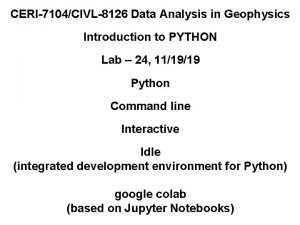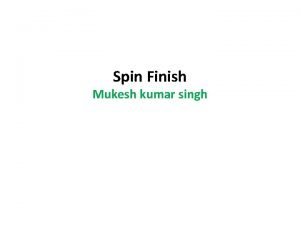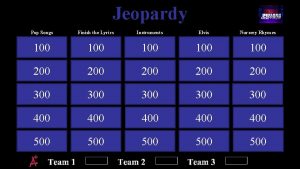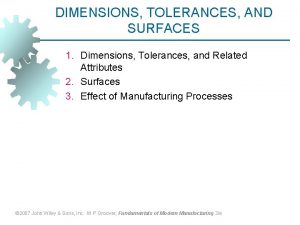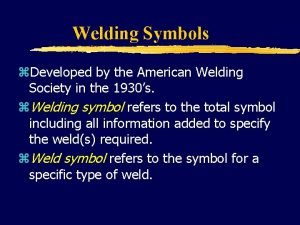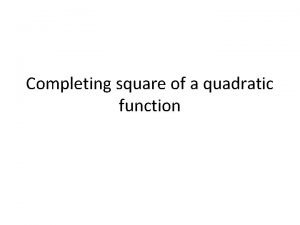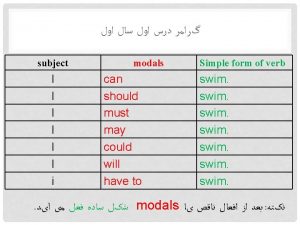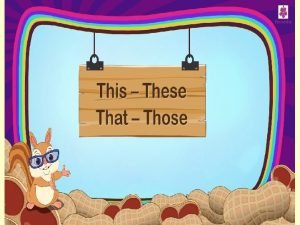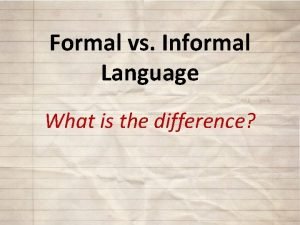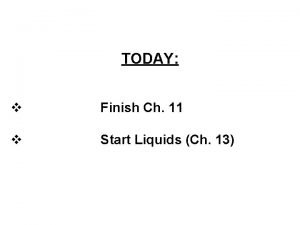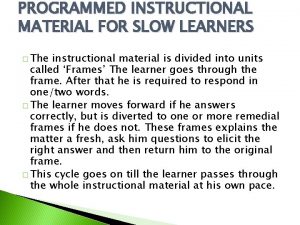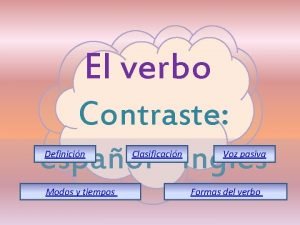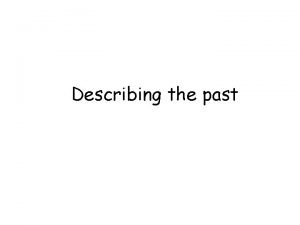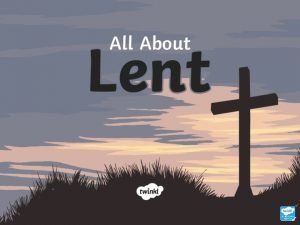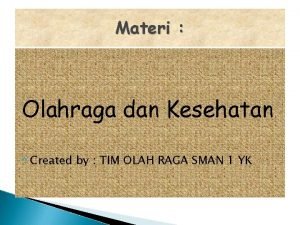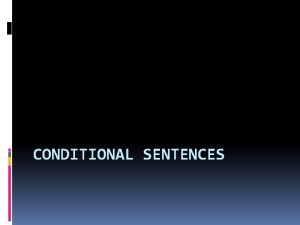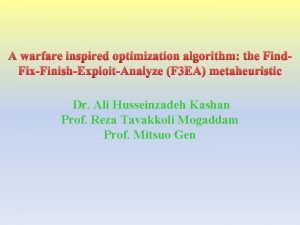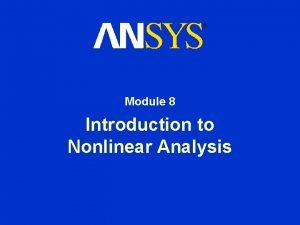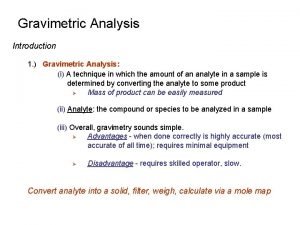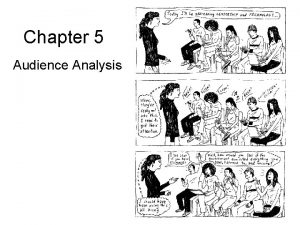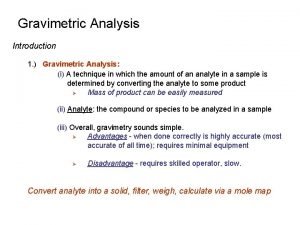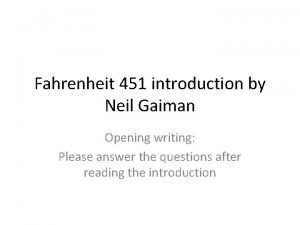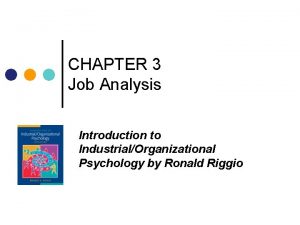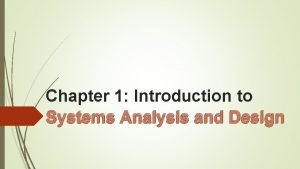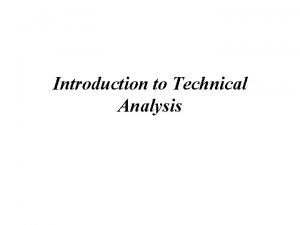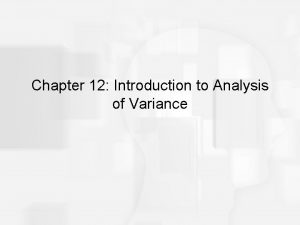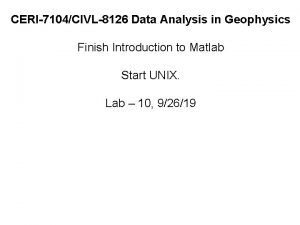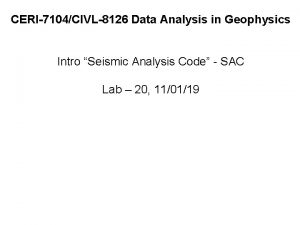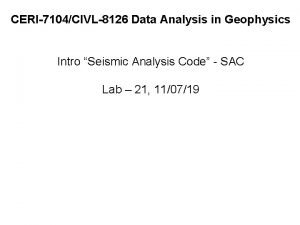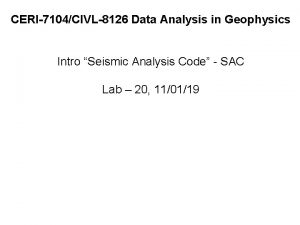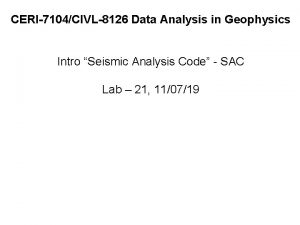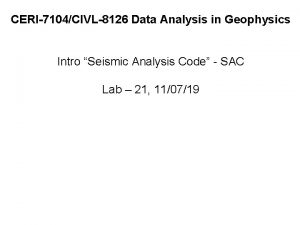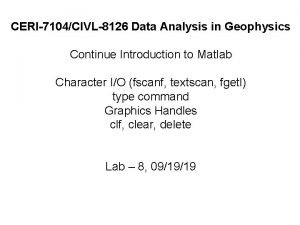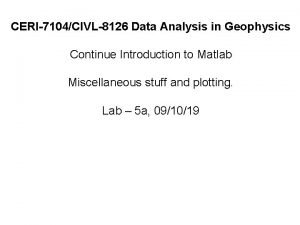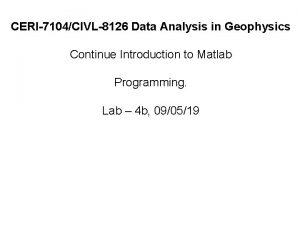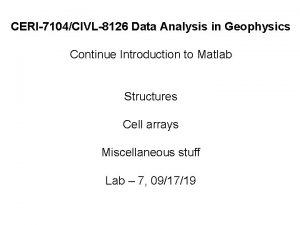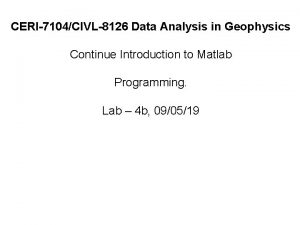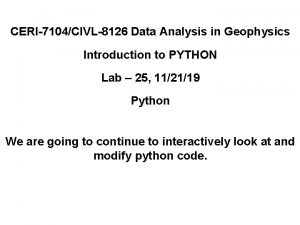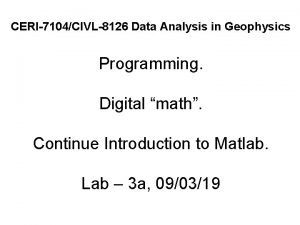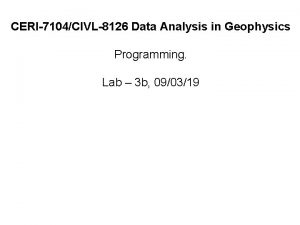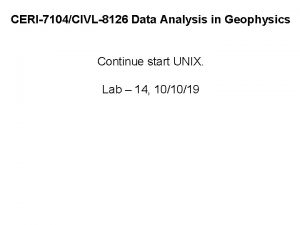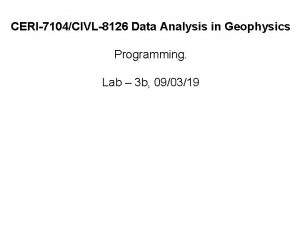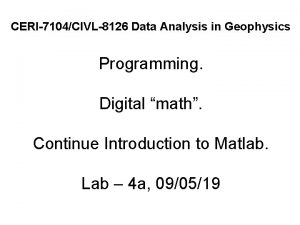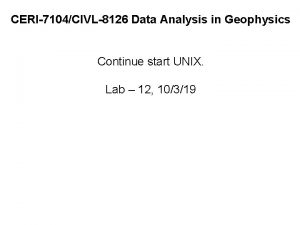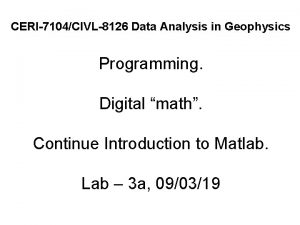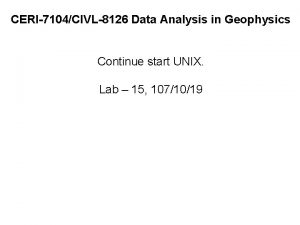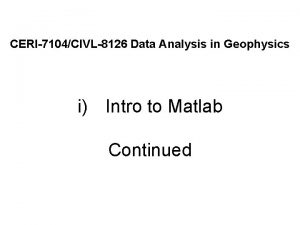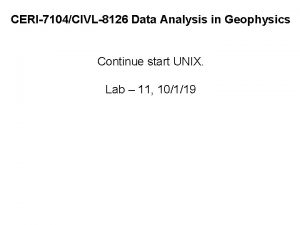CERI7104CIVL8126 Data Analysis in Geophysics Finish Introduction to






























































































- Slides: 94

CERI-7104/CIVL-8126 Data Analysis in Geophysics Finish Introduction to Matlab Start UNIX. Lab – 10, 9/26/19

This web page has the documentation for all the graphics object properties https: //www. mathworks. com/help/matla b/graphics-object-properties. html Go there to see how it is organized.

How to prevent the quotes problem (browser putting in “smart” quotes [the kind you see here – they “open” and ‘close’] ) Use ftp For now – the macs in the lab have a GUI ftp program called Cyberduck. We will see it again later in UNIX. Use it to download the file how 2 handlegraphics. m. Then bring it into the editor in Matlab and it should not have any red stuff.

How to prevent the quotes problem. Or use the dropdown menu to save the file directly (does not go though the browsers interpreter).

You can also give handles to functions, this allows you to pass functions as arguments to other functions f = @(x) x. ^3 -3*x+1; Then call f(3. 4) etc. , (like sin, cosine, etc. ) This also makes function handles – so you can pass functions to other functions X=linspace(0, 2); Plot(x, f(x))

How turn off underscore signifying next character is a subscript (default intrepreter is TEX). This way you don’t have to escape the underscore (“_”) to get it to be an underscore. This is needed when the text is not “hard coded”, eg. a file name. Set the Interpreter property for that field to 'none'; the default for text() fields is TEX. title('This_title has an underline', 'Interpreter', 'none');

Make flow chart of script to read the files mixedin 1. dat and mixedin 2. dat These files have earthquake data. Most earthquake data files have a mixture of numbers and text (the first file) and time formatted data, and a header (that typically identifies the data columns (the second file).

Course Description Introduction to UNIX

What is an operating system (OS or O/S)? Interface between Hardware and User. See: http: //en. wikipedia. org/wiki/Operating_system

What is an operating system (OS or O/S)? Interface between Hardware and User. It is a program (software) designed to manage and coordinate activities and resources of the computer. See: http: //en. wikipedia. org/wiki/Operating_system

What is an operating system (OS or O/S)? Controls the hardware (physical part of the computer memory allocation, fan control, internal and external drive input/output, keyboard and mouse interactions, etc. ) and other software. Controls how other applications (=programs) are implemented. See: http: //en. wikipedia. org/wiki/Operating_system

OS’s at CERI Mac OS X (Darwin/UNIX) UNIX plus Mac GUI �Macs in Student Comptuer Lab in Long Building � many faculty and student offices.

OS’s at CERI Various flavors of Linux Popular, open source version of UNIX (often described as “UNIX-like”, but is UNIX). Found on a number of machines at CERI, but not officially supported at CERI.

OS’s at CERI Windows Student Computer Lab in Long Building, many student offices, UM computer labs and other un-enlightened places.

Why learn Unix/Linux? Designed to be multi-user (from the dark ages when all computers were shared), interactive (as opposed to “batch”), and multi-tasking (sharing again). Invented by and for computer scientists/system programmers (not users or scientific programmers, unfortunately).

This was how you “interacted” with the computer. A teletype. Even today, UNIX assumes you are using a teletype!

Why learn Unix/Linux? Powerful, flexible, and small Hardware independent (these two points are much more important to manufacturers and designers than general users, i. e. us)

Why learn Unix/Linux? “Free” (this is why is it still around) from Bell Labs and Berkley. Open source – “free” – applications, including compilers. Most common free applications designed as part of the GNU Project (GNU’s Not Unix) It is what is running in most geoscience (both university and corporate) labs.

The real reason why to learn Unix/Linux? Because you have no choice (“Resistance is futile”, The Borg, Star Trek). It is what is running in most geophysics departments. Most geophysics tools (SAC, GMT, GAMIT/GLOBK, etc. ) only run on Unix (although there is a Windows version of GMT). (~89% of the worlds computers run some form of Windows, ~9% run some form of the Mac OS, and ~2% run some flavor of Unix. )

Why learn Unix/Linux? “Free” in the sense you don’t buy it from AT&T or Berkley But there is no such thing as a “Free Lunch”. Not “Free” in the sense that you must hire a system programmer/manager otherwise known as a UNIX Wizard or Guru. (another UNIX myth shot down)

A bit of history Originally developed at AT&T in the late 60 s/early 70 s. Freely given to universities in the 70 s. Berkeley scientists continued to develop the OS as BSD Unix in parallel with AT&T (AT&T eventually licensed it for commercial use). Much development, branching, and combining has led to the most common variants of Unix (“flavors” or “distributions” in Unix speak). See http: //www. bell-labs. com/history/unix/

Common flavors at CERI Mac OSX Distributed by Apple, runs on Mac Hardware. Derived from BSD Unix OS on a Mach kernel - Darwin. Linux Free* and commercial# versions available built on a Linux kernel. Flavors most likely to hear about are Red. Hat#, Ubuntu*, Fedora*, Debian*, Suse*, ….

Does this matter? No, the differences between the various flavors of the Unix operating system should not severely affect your work in this class or even much of your research at CERI. BUT

Does this matter? Yes, you need to be aware of OS differences When file sharing with others (this is more of a hardware, rather than an OS, issue). When compiling source code (the executable file is married to OS and hardware). If sharing programs, shell scripts, etc. with others. Or if moving between the different systems at CERI.

Relation to Windows None. Windows Early version built on MS-DOS (which is not really an operating system, it is a file system), which has nothing to do with Unix and everything to do with Microsoft. Cygwin – unix/linux like environment for windows. Have to build everything from source.

Relation to Windows The differences between the Unix Philosophy and the Windows Philosophy … can be boiled down into a question of smarts …. Unix and Windows store the smarts in different places. Unix stores the smarts in the user. Windows stores the smarts in the OS.

Learning curves Enter the concept of the “Learning Curve”. … A "steep" learning curve generally refers to something that requires a lot of initial learning to do anything, even something very simple. A "shallow" learning curve is exactly the opposite; can do simple stuff easily immediately.

Learning curves Armed with those definitions, it's fairly simple to then go ahead and say that Unix has an inherently steep learning curve, and Windows has a very shallow one.

Windows Our Microsoft brethren have taken the approach of making the shallowest possible learning curve.

Windows To take a cue from the fast food industry, Windows is the "under-3" toy of the OS world. The ultimate goal is to flat-out destroy any barrier to entry by removing any requirement for initial knowledge or learning of how and why, and of making the system simplistic enough that it can be used without any understanding of how it works.

Unix The Unix crowd has taken the opposite approach.

Unix has a steep learning curve; it doesn't shield the user from complexity; rather, it revels in the complexity. It recognizes that a general-purpose computer is a fiendishly complicated device capable of doing an unbelievable assortment of things.

Unix It recognizes that the computer is a tool of the user, and so takes a tool-building philosophy. Make a lot of tools, and make each tool specific, and let the user select the tool they think appropriate, and let the user combine the tools however they want. It's not aimed at making things easy; it's aimed at making things possible.

UNIX Philosophy (Mac) “Dilbert” by, Scott Adams, Sep 30, 1994. (Unix)

Backing up a bit to illustrate some concepts. S ell h S ds lic p Ap r he are t O ftw So ase tab es Da ckag Pa Hardware Int e To rnet ols S hel l x an ni m U m Co U s er / n o ati Kernel Sh ell Compilers ll er Us e Sh er s U m te ys

Hardware – the physical computer. Kernel – program, usually hardware dependent, that runs the core or key components of the operating system (process, memory, file, device, and network management). Programs/Applications – hardware independent – unix commands, compilers, applications Shell – hardware independent - how the user interacts with the Programs/Applications layer.

The Shell The UNIX user interface is called the shell. The shell does 4 jobs repeatedly: display prompt read command the shell process command execute command

Final Model

We will now take a short detour to examine the Unix philosophy. It will keep returning to haunt us, but if you understand it, it will make the process less painful.

What is the “Unix Philosophy”? (can computer operating systems have a “philosophy”? ) According to Doug Mc. Ilroy (i)Make each program do one thing well. So, to do a new job, build afresh rather than complicate old programs by adding new features (otherwise known as “bells and whistles”).

What is “Unix Philosophy”? Machine shop vs. appliance (gives you the tools and you to make appliance)

What is “Unix Philosophy”? Advantage - POWERFUL

What is “Unix Philosophy”? Disadvantages - Lots of reinventing the wheel - Requires a more educated user - Requires more work from the user rather than the developer

What is “Unix Philosophy”? Typical question: can UNIX do this? Typical answer: NO, but YOU can write a program! Unix enthusiasts think this is the answer the average user wants to hear!

Caricature of UNIX vs Windows If you need a washing machine Windows gives you a simple washing machine (only one 1 setting, you shouldn’t wash your cashmere sweater, but there are no operating instructions[its intiutive] so you probably don’t know not to wash the sweater and ruined it. ) UNIX gives you a machine shop - you better know 1) how wash different types of clothes and 2) how to design and build a machine to do it.

Quotes for the day: “Software stands between the user and the machine” - Harlan D. Mills Software can help the user in their daily endeavors or stand in the way.

“UNIX Philosophy” (ii) Expect the output of every program to become the input to another, as yet unknown, program. - Don't clutter the output with extraneous information that might be useful to the user, but not needed by the input for next program.

“UNIX Philosophy” Unfortunately this may make things confusing for the uninitiated user. The output is for “next program” (in a “pipe”), not the user.

“UNIX Philosophy” What happens when you ask for a listing of files in an empty directory? Robert-Smalleys-Mac. Book-Pro: untitled folder robertsmalley$ ls<CR> Robert-Smalleys-Mac. Book-Pro: untitled folder robertsmalley$ Returns to prompt without any other output. (there are no files to list, so Unix just outputs a <CR> [and a new prompt], is that reasonable? ). (Works differently in shell script, no <CR>)

“UNIX Philosophy” What happens when you enter Robert-Smalleys-Mac. Book-Pro: documents robertsmalley$ echo<CR> The command echo, “echoes” what you type. Should do nothing! (what about a new prompt on same line? ) (i. e. it should just sit there, with the “cursor”, which was invisible on a teletype after the <CR>, after the <CR> waiting for input)

“UNIX Philosophy” What happens when you enter Robert-Smalleys-Mac. Book-Pro: documents robertsmalley$ echo<CR> Usually goes to next line and prints the prompt on the screen as in the previous example(break with philosophy because philosophy too confusing But does what expected, nothing (it follows philosophy), in a shell script.

“UNIX Philosophy” Idea of “filter” – Every program takes its input from Standard IN (originally a teletype, now a keyboard), does something to it (“filters” it) and sends it to Standard OUT (originally a teletype, now a screen) (notice that the “user” is not part of this model).

“UNIX Philosophy” This brings up another issue – commands sometimes behave differently in shell scripts than they do “interactively” Typically more “chatty” when interactive. This kind of stuff can make for confusion when debugging. Works from screen, does not work in shell script.

“UNIX Philosophy” It is pretty easy to see these are not a good assumptions (Stnd IN, Stnd OUT) for many tasks and many Unix commands break this convention.

“UNIX Philosophy” Idea/use of – redirection (“<“, “<<“ and “>”, “>>”) - Take input from somewhere rather than Standard IN - Send output to somewhere rather than Standard OUT (Unix treats everything like a “file”, even hardware)

“UNIX Philosophy” redirection - Take input from a file “<“ rather than Standard IN - Send output to a file “>” rather than Standard OUT (note that this will create the file first – before running the program. If you have an existing file with that name – guess what UNIX does with it?

“UNIX Philosophy” - Send output to a file “>” rather than Standard OUT (note that this will create the file first – before running the program. If you have an existing file with that name – guess what UNIX does with it? UNIX ERASES it! The response form your UNIX guru will be “you were told that’s what would happen!” UNIX dutifully did what you told it to do!!

“UNIX Philosophy” Redirection - Take input from what follows “<< END“ (in shell script, or Standard IN, till finds character string END ) - Append output to an existing file “>>” rather than Standard OUT

“UNIX Philosophy” Idea/use of – pipes (“|”) Sends output to the next program (instead of “standard out” or a file) And Takes input from the previous program (instead of “standard in” or a file)

“UNIX Philosophy” Example: we have two files with a name and student ID on each line. There are some duplicates (i. e. exact same line, character for character, in both files). We want one file, in alphabetical order, with duplicates removed. cat file 1 file 2 | sort –u > file 3 (cat does not require input file redirection, it will take a list, redirection does not even work with more than one file)

Write programs to handle text streams, because that is a universal interface. (fine if you’re a system programmer, not always so useful for scientific data crunching. Good example of a real problem that does not follow this model is earthquake location. You typically have one static text file for station locations, another stationary one for the velocity model, and a final text file with station names and arrival times for an earthquake. This does not fit the serial, filter model. Another example, binary seismic, topo, etc. data. )

“UNIX Philosophy” Continued Avoid stringently columnar or binary input formats. (Avoid, but sometimes necessary. Not closely followed by many programs. ) Don't insist on interactive input. (Does not fit in with use of pipes. ) Instead, control is implemented by use of “command line switches”

“UNIX Philosophy” Put lots of (simple, easy to write) single minded programs in a row (with pipes) to do what you need. (Don’t use temporary/intermediate files – use a pipe).

“UNIX Philosophy” New concept use of – command substitution (`…`) (uses “backwards” or French grave accent) Use the output of a command as ‘some sort of input’ to another command.

command substitution example. Suppose I want to print something and would like to control its orientation – landscape or portrait. ORIENT=<CR> Or ORIENT=-P<CR> Then print `echo $ORIENT` < INFile<CR> Puts in nothing, in case of ORIENT=<CR>, or “-P”, in case of ORIENT=-P<CR>, into the command as if that is what you typed (this is not how you would actaully do this – it is a ginned up example)

REVIEW Write programs that do one thing and do it well. (lean and mean) Write programs to work together. (pipes)

“the UNIX operating system, a unique computer operating system in the category of help, rather than hindrance. ” Introducing the UNIX System Mc. Gilton and Morgan, 1983. or The trouble with UNIX: The user interface is horrid Norman, D. A. Datamation, 27, No. 12, 139 -150.

"Two of the most famous products of Berkeley are LSD and Unix. I don't think that this is a coincidence. ” Anonymous

Before looking at more Unix commands, we will first look at the FILE STRUCTURE (how files [called documents on Mac and Windows] are stored/organized). Unix uses a hierarchical file system (as does Mac and Windows/DOS).

Looks like an upside down tree. Starts at top with “/”, called “root”. Unix uses the “/” to separate directories (known as folders on Mac or Windows) Top Level Directories Levels of sub Directories

File names – the “separator is “/”. root (first slash) then path and filename /usr/libc. a

This is the full name from root (works from anywhere – i. e. any directory), if you were in the directory usr, you only need lib/libc. a (no leading slash)

And if you were in the directory lib, you only need libc. a (no leading slash)

The “/” (slash or forward slash) in Unix is roughly equivalent to the “” (backslash) in Windows/DOS.

Some commands: pwd – print working directory – tells us where we are in the directory tree. smalleys-imac-2: usr smalley$ pwd<CR> /usr smalleys-imac-2: usr smalley$

How to move between directories – going up and down the directory tree– To go down to the directory doc we use the “change directory” = “cd” command smalleys-imac-2: usr smalley$ cd doc<CR> smalleys-imac-2: doc smalley$

Now smalleys-imac-2: usr smalley$ pwd<CR> /usr/doc smalleys-imac-2: doc smalley$

Some details of the prompt you can control all this - the prompt has been programmed to tell us a bunch of stuff! (power of unix. ) Machine Directory name (in this case without full path) User name Text string smalleys-imac-2: usr smalley$

Aside: Unix sub philosophy – Minimize typing (on teletype) – so use short (2, in extreme cases 3 character) command names constructed from description of the command. e. g. “cd” for “change directory” (Unix fans claim this is a “feature” of Unix, compared to other O/Ses)

We can also go up the directory structure. To return to usr from doc$ cd. . <CR> usr$

This is a little strange --The double dot (“. . ”) signifies the directory directly above you (up) in the directory structure (tree).

We can also go directly to anywhere in the directory structure using the full path. To go to usr (from doc or anywhere, such as pub) doc$ cd /usr<CR> usr$

Notice that you have to know where you are in the tree and what subdirectories are contained there to navigate down. Unix does not provide a display of the picture below. You need to have it in your head.

How do we go from doc to lib? We could do this using the full path. doc$ cd /usr/lib<CR> lib$

How do we go from doc to lib? But here’s an easier (? ) way – we have to go up one level; then down one level. This can be done with the command. doc$ cd. . /lib<CR> lib$

Say we want to go to “pub” lib$ cd. . /home/ftp/pub<CR> We went up two, then down three.

Say we want to go to “pub” We could also have done (and is simpler) this with the full path. pub$ cd /home/ftp/pub<CR>

Go directly to “root” directory (“/”) lib$ cd /<CR> /$

Go from anywhere directly to your “home” directory (assume I’m “lisa”). CS 171$ cd ~<CR> lisa$ uses tilde “~”

Go from anywhere directly to someone else's home directory (assume I’m lisa) lisa$ cd ~joe<CR> /home/joe lisa$ also uses tilde “~”

The tilde character “~” -refers to your home directory when by itself, - or that of another user when used with their home directory name (the same as their user name). (The shell expands the “~” into the appropriate character string for the full path - “/home/joe” or “/home/lisa”)

Review - specifying file names full path /usr/libc. a relative path (if in directory lib) libc. a (if in another directory next to it, e. g. doc a

Review - specifying file names abbreviations (if I am joe) (if I am not joe) ~/CS 171/hello. cc ~joe/CS 171/hello. cc

You have to keep track of the file structure in your head or have a way to find out what files are in the working directory.
 Python for geophysics
Python for geophysics Paul sava
Paul sava Seismology
Seismology Wireline geophysics
Wireline geophysics Introduction of data analysis and interpretation
Introduction of data analysis and interpretation Introduction to data warehousing and data mining
Introduction to data warehousing and data mining Sources of content analysis
Sources of content analysis Research procedure in methodology
Research procedure in methodology Data preparation and basic data analysis
Data preparation and basic data analysis Data acquisition and data analysis
Data acquisition and data analysis Dear mr email
Dear mr email Your homework finished last night
Your homework finished last night Staqc south tees
Staqc south tees Rough sketch and final sketch
Rough sketch and final sketch Physical finishes
Physical finishes Fabric finish
Fabric finish Spin finish oil formulation
Spin finish oil formulation What do we use should for
What do we use should for Simple past paint
Simple past paint Verb 3 cute
Verb 3 cute Jeopardy final question music
Jeopardy final question music Wall finishing materials
Wall finishing materials Finish the sentence icebreaker
Finish the sentence icebreaker What to put at the end of a letter
What to put at the end of a letter Complete the sentences using reported speech.
Complete the sentences using reported speech. External and internal finish lines in rpd
External and internal finish lines in rpd Bilateral tolerance
Bilateral tolerance Complete the sentences if i pass my exams
Complete the sentences if i pass my exams What do these sentences express
What do these sentences express Precision attachment parts
Precision attachment parts Enjoy finish
Enjoy finish Weld mapping symbols
Weld mapping symbols Test to see if your dirty minded
Test to see if your dirty minded What did you do last week?.......in the pool.
What did you do last week?.......in the pool. Present tense finish
Present tense finish The trust giant's point of view
The trust giant's point of view I have already eaten my breakfast
I have already eaten my breakfast Habit 2 worksheet
Habit 2 worksheet Agape love
Agape love Easy care finish
Easy care finish Completing the square (continued)
Completing the square (continued) Finish the slogan quiz
Finish the slogan quiz Encourage verb pattern
Encourage verb pattern The race for excellence has no finish line
The race for excellence has no finish line شکل سوم swim
شکل سوم swim Singular far
Singular far Characteristic of informal language
Characteristic of informal language Finish
Finish Ramit can finish his work in 25 days
Ramit can finish his work in 25 days Finish the following sentence
Finish the following sentence Find the diagonal way from start to finish.
Find the diagonal way from start to finish. Roughness symbol
Roughness symbol Should finish
Should finish River thames source
River thames source Finishgrant link
Finishgrant link Diferencias entre modo indicativo y subjuntivo
Diferencias entre modo indicativo y subjuntivo Pause breathe finish up
Pause breathe finish up Tense ต่างๆ
Tense ต่างๆ Period of lent
Period of lent Finish commercial
Finish commercial Teknik melewati garis finish
Teknik melewati garis finish Finish these sentences
Finish these sentences Before you finish eating breakfast this morning
Before you finish eating breakfast this morning Find-fix-finish-exploit-analyze targeting model
Find-fix-finish-exploit-analyze targeting model Intro paragraph outline
Intro paragraph outline Introduction to systems analysis and design
Introduction to systems analysis and design Introduction to nonlinear analysis
Introduction to nonlinear analysis Hunger games setting quotes
Hunger games setting quotes Introduction to poetry by billy collins
Introduction to poetry by billy collins Algorithm analysis examples
Algorithm analysis examples Gravimetric analysis
Gravimetric analysis Affiliation audience analysis
Affiliation audience analysis Introduction to factor analysis
Introduction to factor analysis How to write a character analysis thesis
How to write a character analysis thesis Volumetric analysis equipment
Volumetric analysis equipment Literary analysis introduction
Literary analysis introduction Speech analysis introduction
Speech analysis introduction Gravimetric analysis notes
Gravimetric analysis notes Fahrenheit 451 introduction neil gaiman
Fahrenheit 451 introduction neil gaiman Job analysis in psychology
Job analysis in psychology Introduction to system analysis and design
Introduction to system analysis and design Introduction of design and analysis of algorithms
Introduction of design and analysis of algorithms Titration introduction
Titration introduction Symbols in hamlet
Symbols in hamlet Swot analysis introduction
Swot analysis introduction Usha analysis
Usha analysis Decision tree approach
Decision tree approach Introduction of technical analysis
Introduction of technical analysis Difference between fea and fem
Difference between fea and fem Swot analysis introduction
Swot analysis introduction C programming lectures
C programming lectures Human resource planning introduction
Human resource planning introduction Introduction of financial statement analysis
Introduction of financial statement analysis Introduction to analysis of variance
Introduction to analysis of variance An introduction to analysis
An introduction to analysis
